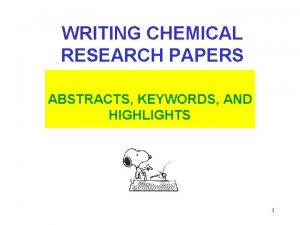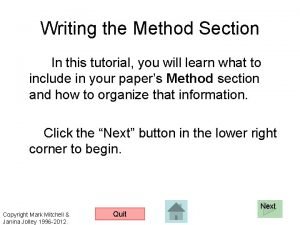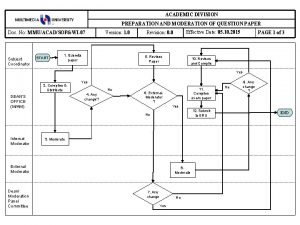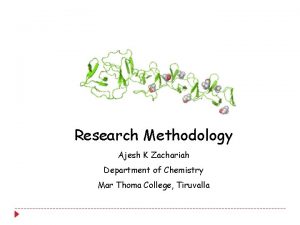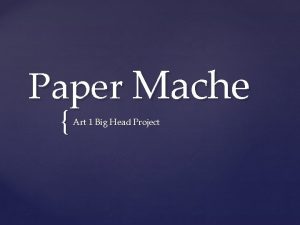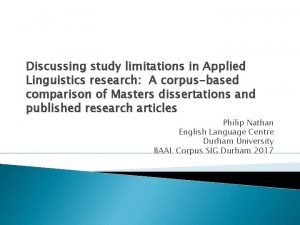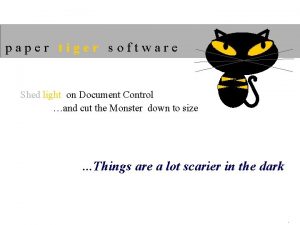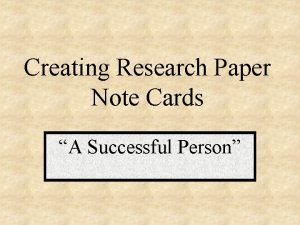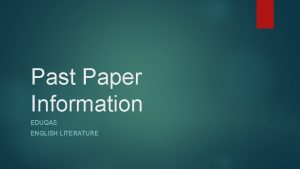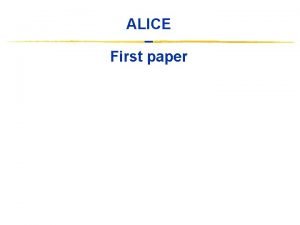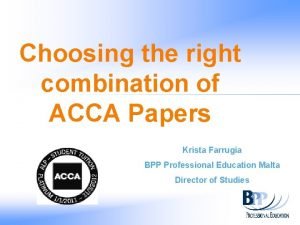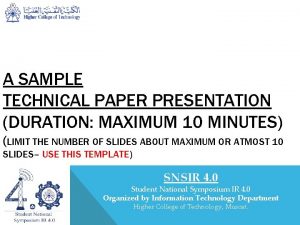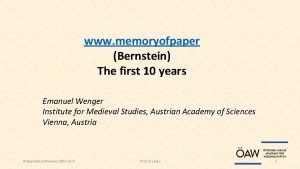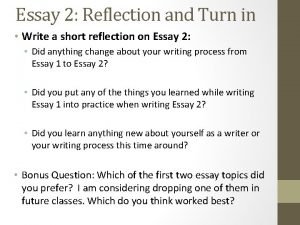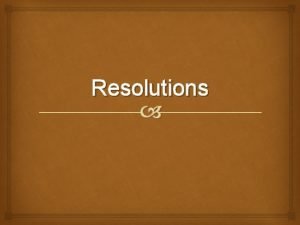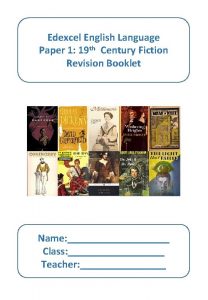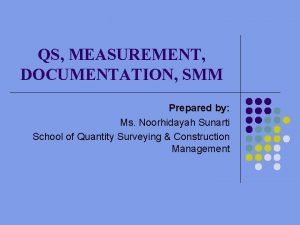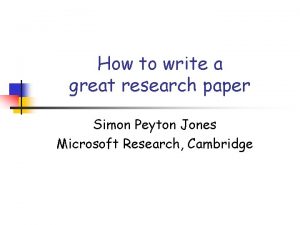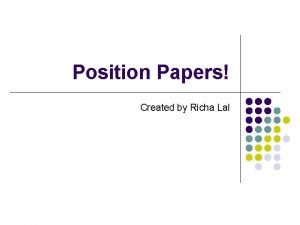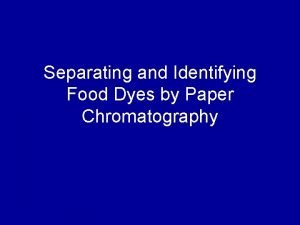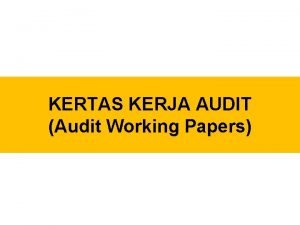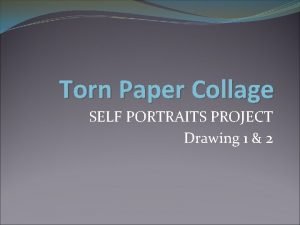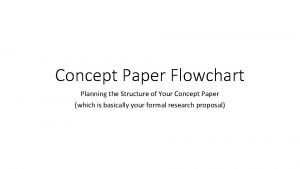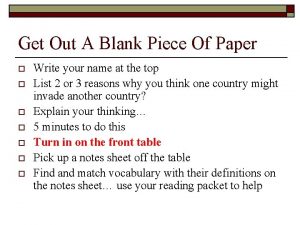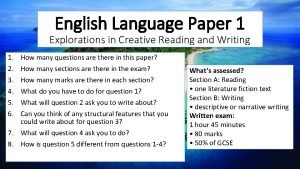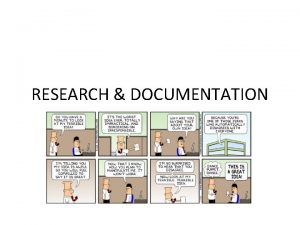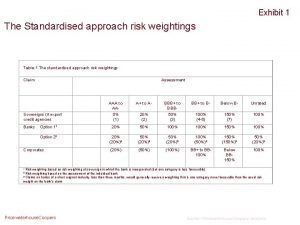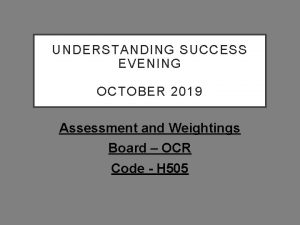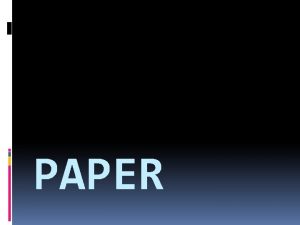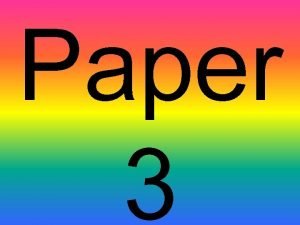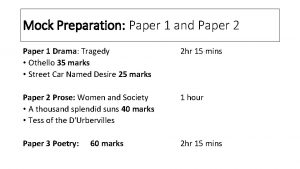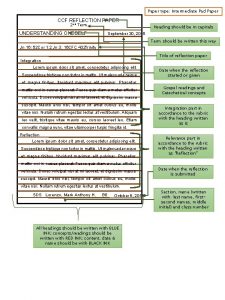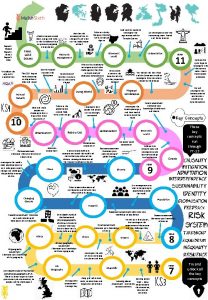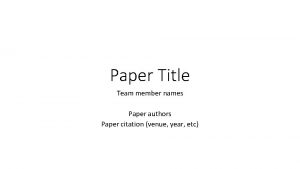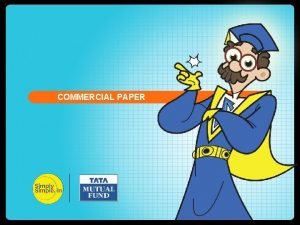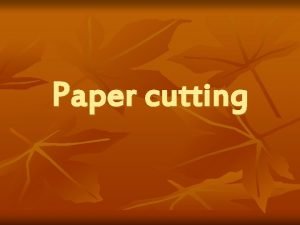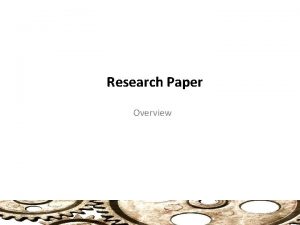G C S E weightings Paper 1 is











































- Slides: 43

G. C. S. E weightings • Paper 1 is 40% of your overall Language G. C. S. E • Paper 2 is 60% of your G. C. S. E.

Before you begin • Breathe… • Read each question carefully at least twice before you read the specific lines. • Mark your question paper where you should stop reading for each question. • Mark by this line the approximate time that you should exit this question. • Read the specific lines with the question in mind, use a highlighter or underline the key evidence that will help you. • Be specific- too much highlighting or underlining will make it difficult to work out which evidence to use.

Doing the exam • Track the text chronologically. • Make clear points with evidence from the specific lines/text. • Choose quotes carefully. It is not necessary to quote whole sentences - focus on words/phrases that allow you to make your point fully.

How it adds up. • 5/10 =grade 4 • 6/10 = grade 5 • 7/10 = grade 6 • 8/10 = grade 7 • 9/10 = grade 8

AO 3 Compare and contrast question Paper 2

• You will compare and contrast in the Literature poetry papers and Language paper 2.

Language paper 2 • AO 3 Compare writer’s ideas and perspectives, as well as how these are conveyed across two or more texts. Questions could begin with… • Compare the following… • Identify similarities and differences

Comparison questions. • This type will often tell you the focus for comparison. In the first line, it might say… ‘Both of these texts are about…’ or ‘In both of these texts, the writers give their views on…’ • Draw out the differences and similarities in what they say and how they say it.

How to do it. • You must compare each point as you go along. • It is no good writing a few points about one text and then writing another few points about the text. • THIS IS NOT COMPARING AND CONTRASTING! Instead • Rishton uses humour to engage the reader when she says ‘………………’ In contrast, Smith decides to engage the reader with an extensive use of knowledge about Shakespeare as he refers to the writing methods that Shakespeare such as ‘………………. ’

Comparing and contrasting • You must clearly identify which text you are referring. To avoid errors, use the writer’s name. Not • Extract 1 uses humour to… But • Jennings uses humour to…

Making Connections Use a series of comparisons, using connectives to link ideas, both within paragraphs and between paragraphs. Similarity Connectives • equally • in the same way • similarly • likewise • just as…also Contrast Connectives • in contrast • however • whereas (best used in the middle of a sentence) • on the other hand Refer back to the question repeating the key words from it.

AO 4 Evaluation question

A 04 - evaluate • Evaluate texts critically and support this with appropriate textual references. • If it asks for how you think or feel, you are not to have a rant about why you despise child labour. You must use the text to explore your personal feelings. • It is asking you to explain and analyse what a writer does in order to make you respond as you do.

What do you need to do. • Track through the text chronologically. A writer may be trying to manipulate your response through the structure of the text. Tracking the text will make sure that your response follows the sequence of events and do not miss vital clues. • Stick close to the question and the text- answer it! • Evidence from the text. • Do not be afraid to disagree with what the task is saying as long as you can support it.

• 5 -6 marks (grade 4&5) • You give an evaluation (summary) of the text and the effects that the text has. You must use references to the text to support your evaluation. • You will some critical awareness of the text. Eg; even though life in S Africa for a miner is shown by the writer to be difficult I feel sympathy for Obed as he is forced to leave ‘I knew I could not stay in the mines or I would be in danger’.

Pick out language for 7 -8 • 7 -8 marks (grade 6&7) • You give a critical evaluation of the text and its effects. You must support this by well selected references to the text. • You show critical awareness and engagement with the text. Eg’ the writer presents it as necessary for Obed to leave S Africa as the danger for him is still present as he has to leave the mines ‘secretly’. Whilst there is undoubtedly sympathy, the reader also feels relief as he is safe and pleased to be back at home.

• 9 -10 marks (grade 8&9) • You give a persuasive evaluation of the text and its effects. • You support with convincing, well selected examples and precise textual references. • Your responses show engagement and involvement. • You take an overview (look at the big picture) to make accurate and perceptive comments. Eg; the writer conveys a sense of unfairness in the lack of justice in S Africa, that whilst the Zulus literally ‘get away with murder’, Obed is the one who pays the price by having to leave his relatively well=paid job ‘secretly’. However, our sympathy is not fully engaged as the writer knows that Obed feels that he has left a prison and we know that he is now free.

Questions could begin with… • To what extent do you agree…? • Evaluate… • How effective is…? • What do you think and feel…? • State how you react to the following lines.

EUDQAS Page 117 - 10 minute task • What do you think and feel about the argument that little liars grow up to be great leaders? You should comment on: • What is said • How it is said.

Book 2, page 43 -44 • How do you react to what takes place in these lines.

Book 2, page 46 -47 • Complete the task independently and self-assess it on page 48.


A 02 Explain, comment on and analyse Use terminology.

AO 2 • The important part of this Assessment Objective is the word ‘relevant’. • If the writer has used for imagery for effect and you recognise this, write it down, yet be sure to explain how the writer has done that.

What do you need to include in your answers… • Zoom in on language • Structure • Terminology • Effect on the reader

Questions could begin with… • Explain • How does the writer…? Compare the following… • Analyse • What impressions…?

A 02 - explain, comment on or analyse • AO 2 Explain, comment on or analyse how writers use language and structure to achieve effects and influence readers, using relevant terminology to support their views. • How does the writer use language (words/phrases) and what is its effect? • How does the writer organise the piece of writing and for what effect?

Impressions/effect • The effect created by the writer by the way that the words and devices are deliberately used to create an impression or develop the thinking of the reader.

Read book 2, page 32 -33 • How does the writer create the impression that this day is out of the ordinary? • Discuss. An ‘impression’ question means looking closely at the language! • Overview of an impressions question- What specific words give you this impression and use terminology to say it.

Looking at language • You need to study how a writer has used words and phrases to create meaning.

Book 2, page 25 - language • What impressions do you get of Patrick in these lines? Overview of an impressions question. What specific words give you this impression and use terminology to say it.

Looking at structure • You need to look at the ways that the words, sentences and paragraphs have been ordered. A writer deliberately organises their writing to influence the reader and create effects.

Book 2, page 28 - structure • How does the writer make these lines tense and dramatic? • How does the writer encourage you to feel sympathy for Marvin?

Book 2 - how a writer influences a reader • Page 36 -39 • How does the writer make this part of the story tense and dramatic?

Bringing it all together. • A writer uses their writing tools (language, structure, devices etc) to influence a reader. Think about how they use those tools to influence the way a reader may respond to or engage with the text.

Book 2, page 41 • How does the writer develop a sense of drama in this extract? (10)

AO 1 Identify, interpret explicit and implicit information and ideas. Select and synthesise evidence from different texts.

Interpret explicit and implicit information and ideas. • Explicit- something that is obvious from the text. For example, the waiter is always dropping things. This is because the text tells you that he is always dropping things. • Implicit- a hidden meaning. For example, you conclude that ‘the waiter is clumsy. ’ This is because you read about him dropping things on more than one occasion.

Top tips • A point. • Select evidence from the text. • Explain what it means. • You must present a range of different but relevant points. • Avoid repeating yourself.

Select and synthesise evidence from different texts. • Only applies to Paper 2. • You must read both texts carefully and combine the information required in your answer. • Top mark answers ‘provide an overview’. This means that the pupil has take a step back from the detail and considered the bigger picture of the texts.

Select and synthesise evidence from different texts. • Try the task on page 80, book 2.

AO 1 questions could begin with… • Identify • List- must be complete sentences. • Select • Summarise • Synthesise

A ‘list’ question • You should be writing a minimum of six different points for a 5 mark question. • Write in full sentences, using quotes, but do not copy full unabridged quotations. • Be concise (to the point) and list a minimum of five. • Make sure that each point is a separate point. • Make sure that you answer the question within the designated lines.
 Paper 2 aice general paper
Paper 2 aice general paper Aice general paper essay example
Aice general paper essay example Graphical abstract example
Graphical abstract example What is paradigms in hci
What is paradigms in hci Does apa have a title page
Does apa have a title page Ethical consideration example in research
Ethical consideration example in research Wadding up paper
Wadding up paper Example of participants section in research paper
Example of participants section in research paper Question paper moderation tool
Question paper moderation tool English language gcse edexcel
English language gcse edexcel Example of methodology section of research paper
Example of methodology section of research paper 0470/23/o/n/17
0470/23/o/n/17 Sheen big head
Sheen big head Example of scope of the study in thesis
Example of scope of the study in thesis Paper tiger software
Paper tiger software Source cards for research paper
Source cards for research paper Eduqas english literature past papers
Eduqas english literature past papers Hlt paper size
Hlt paper size Acca levels
Acca levels Patty paper math
Patty paper math Gcse computer science paper 2
Gcse computer science paper 2 Paper presentation samples
Paper presentation samples Emanuel wenger
Emanuel wenger Gumuhit ng isang larawan sa isang short bond paper
Gumuhit ng isang larawan sa isang short bond paper Staar essay lined paper
Staar essay lined paper Reflective writing examples
Reflective writing examples Preambulatory clauses
Preambulatory clauses Edexcel english language paper 1
Edexcel english language paper 1 Measured works in bill of quantities
Measured works in bill of quantities Simon peyton jones how to write a great research paper
Simon peyton jones how to write a great research paper Position paper structure
Position paper structure Paper chromatography of food dyes
Paper chromatography of food dyes Grab some paper
Grab some paper Working paper audit adalah
Working paper audit adalah Torn paper portraits
Torn paper portraits Concept paper structure
Concept paper structure Brawney paper towel
Brawney paper towel Take out a piece of paper
Take out a piece of paper Explorations in creative reading and writing
Explorations in creative reading and writing What are finance companies
What are finance companies Documentation in research paper
Documentation in research paper Child health nursing gnm 2nd year question paper
Child health nursing gnm 2nd year question paper Fictional character names
Fictional character names Schoenbein paper
Schoenbein paper


